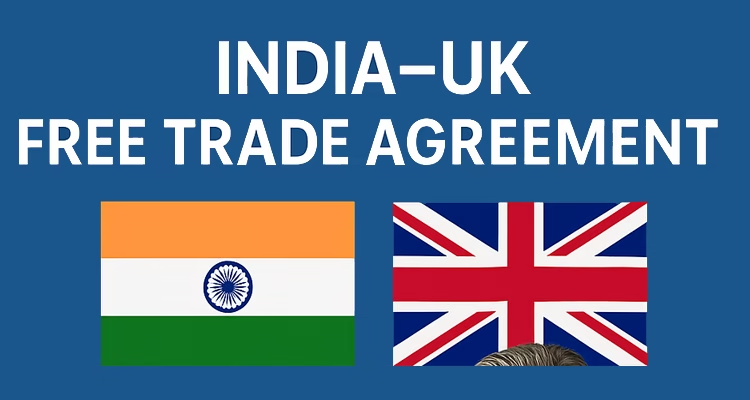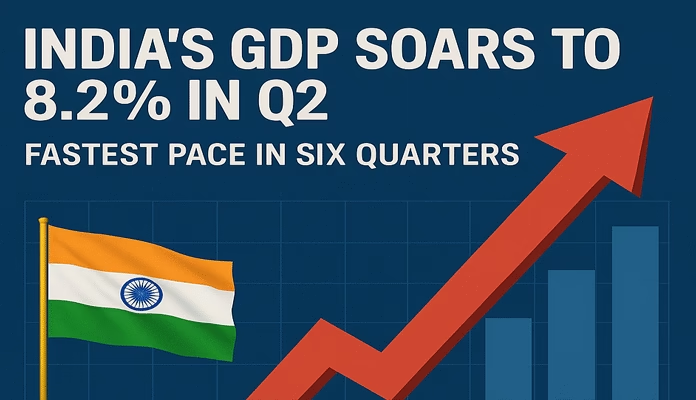
 In a watershed moment for modern geopolitics and North–South cooperation, India and the United Kingdom signed a historic Free Trade Agreement (FTA) on July 24, 2025. The deal opens new trade avenues projected to be worth over $120 billion annually by 2030, setting the stage for a transformative chapter in economic diplomacy—especially for the Global South.
In a watershed moment for modern geopolitics and North–South cooperation, India and the United Kingdom signed a historic Free Trade Agreement (FTA) on July 24, 2025. The deal opens new trade avenues projected to be worth over $120 billion annually by 2030, setting the stage for a transformative chapter in economic diplomacy—especially for the Global South.
Unlike traditional tariff-cutting pacts, the India–UK FTA is a forward-looking, comprehensive deal that positions India as a strategic economic bridge between the West and the Global South. It is also the first such agreement signed by a major South Asian nation with the post-Brexit UK, reaffirming India’s leadership among emerging economies and strengthening its image as a credible alternative to China’s regional dominance.
Key Economic Provisions: A Win-Win Approach
Under the agreement, over 99% of Indian exports to the UK—including textiles, leather, marine products, pharmaceutical generics, and auto components—will now enjoy zero-duty access, significantly benefiting India’s MSME sector and labor-intensive manufacturing hubs.
In return, India has agreed to reduce tariffs on Scotch whisky and luxury automobiles, a move that reflects its pragmatic, mutually beneficial trade policy. The agreement strikes a delicate balance between protecting domestic industries and embracing global trade opportunities.
A Model for the Global South
For developing nations, the India–UK FTA marks a precedent-setting moment. It demonstrates that fair, rules-based trade with developed nations is possible without surrendering sovereignty or development priorities. Notably, India successfully excluded provisions like patent term extensions in the pharmaceutical sector, protecting its vital generics industry—a key healthcare lifeline for regions like Africa, Latin America, and Southeast Asia.
This outcome sends a strong message to the Global South: equitable globalisation is achievable when negotiations are rooted in strategy, sovereignty, and self-respect.
Strategic and Regional Impact
The FTA is expected to generate close to one million jobs in India by 2030, primarily through increased exports and expanded industrial output. Its regional spillover effects are also significant, strengthening supply chains that link India with Bangladesh, Nepal, and Sri Lanka, and uplifting smaller South Asian economies.
This shift positions India not just as a regional power, but as a growth engine for the entire Global South.
Diplomatic Symbolism and Global Relevance
Coming at a time of economic nationalism in the West and global instability due to conflicts like the Iran–Israel crisis, the timing of this agreement is symbolically powerful. Both Prime Ministers—Narendra Modi of India and Keir Starmer of the UK—have called it a “historic day” and a “blueprint for shared prosperity.” The visual of the two leaders shaking hands as trade equals marks a departure from past donor-recipient dynamics and affirms the rise of multipolar global diplomacy.
India’s firm stand on climate clauses, digital trade, and labor standards further underscores its maturing foreign policy. It refused to accept conditions that could compromise domestic innovation or employment, thereby crafting a new model of South-led multilateralism.
Challenges and Trade-offs
India will bear a short-term revenue loss, estimated at ₹4,060 crore in the first year, as customs duties are lowered. Critics argue this could strain government spending or reduce support to rural sectors. However, the Indian government maintains that long-term gains—from expanded tax revenues and industrial growth—will far outweigh the initial fiscal pain.
As The Economic Times notes, such trade-offs are calculated risks that emerging powers must take to ascend to global economic leadership.
Implementation and Outreach
To ensure that the FTA’s benefits are widely distributed, the Indian government has launched sectoral advisories and regional outreach programs. Key industries—leather, garments, marine products, and IT services—are being encouraged to realign production and compliance structures to capitalize on the new trade landscape. The goal is to ensure that gains reach beyond urban conglomerates and into Tier-2 and Tier-3 cities.
India’s Rising Soft Power
At a deeper level, the agreement bolsters India’s soft power. The narrative of a self-assured India offering market access, supply chain resilience, and skilled human capital—rather than seeking aid—resonates globally. For the UK, grappling with post-Brexit stagnation, India emerges not just as a trade partner but as a strategic ally and counterbalance to China.
This enhances India’s standing at multilateral platforms like the WTO, UNCTAD, and World Economic Forum, where it can now credibly push for reforms to foster equitable global governance.
A Blueprint for South–North Trade Partnerships
The FTA is already being viewed as a blueprint for other Global South nations, particularly in Africa and ASEAN, seeking alternatives to Chinese debt dependency and rigid EU frameworks. India’s model offers a “third way”: smart, sovereign, and sustainable trade relationships rooted in mutual respect.
Of particular interest are the provisions around service sector mobility, which will ease access for Indian professionals and students to the UK’s job market and educational institutions. These could serve as templates for diaspora-driven economic diplomacy in other South–South or South–North contexts.
A Turning Point in Global Trade
The India–UK Free Trade Agreement is more than just a bilateral deal. It is a diplomatic statement, an economic milestone, and a strategic assertion. For the Global South, it represents a future where trade liberalisation can coexist with sovereignty and self-reliance. For India, it is a bold demonstration of its capability to lead and influence global economic norms. And for the world, it reaffirms that true partnerships—built on respect, reciprocity, and resilience—can redefine the global trade order.
As countries across Africa, Asia, and Latin America navigate a fragmented global economy, India’s FTA with the UK offers a compelling roadmap—one that balances ambition with responsibility, growth with equity, and sovereignty with global integration.
This landmark agreement has not just opened a corridor between Delhi and London, but has unveiled a gateway of possibilities for the Global South as a whole.
(Written by Aditya P. Verma, Research Scholar, International Relations, Lucknow University)



